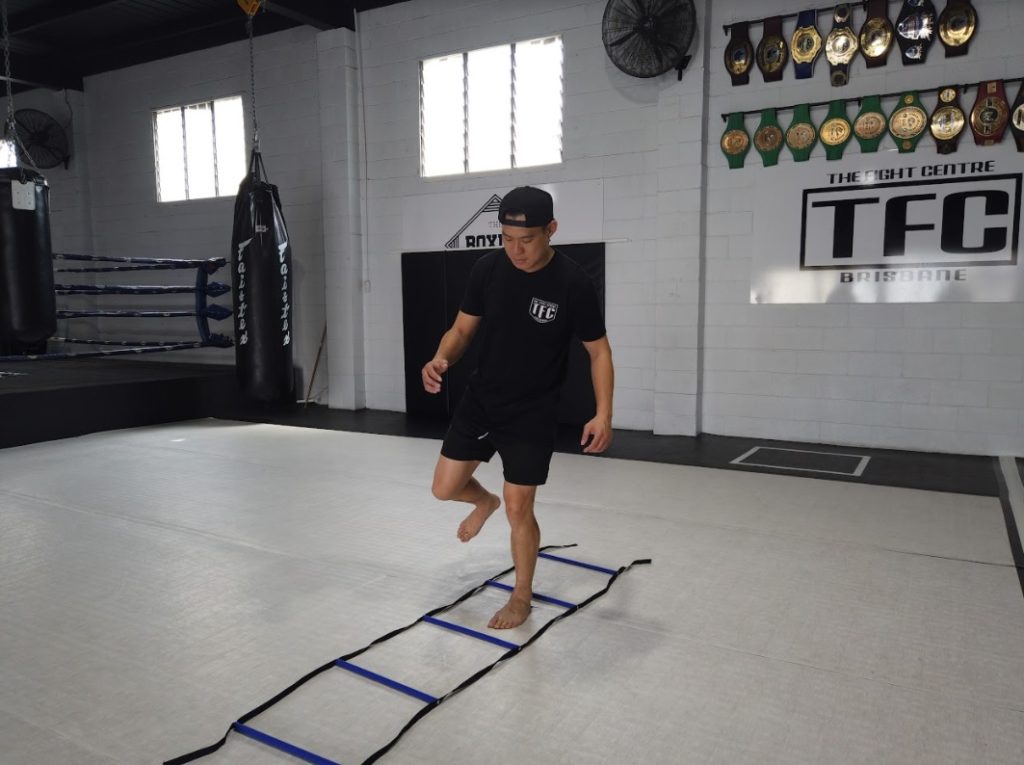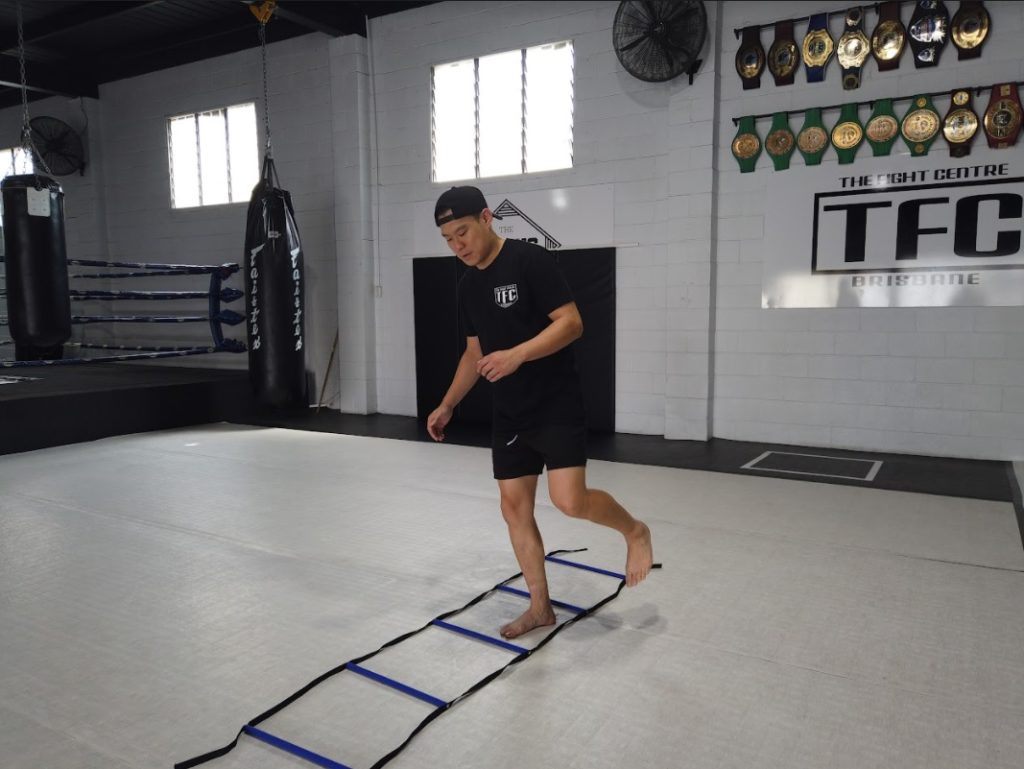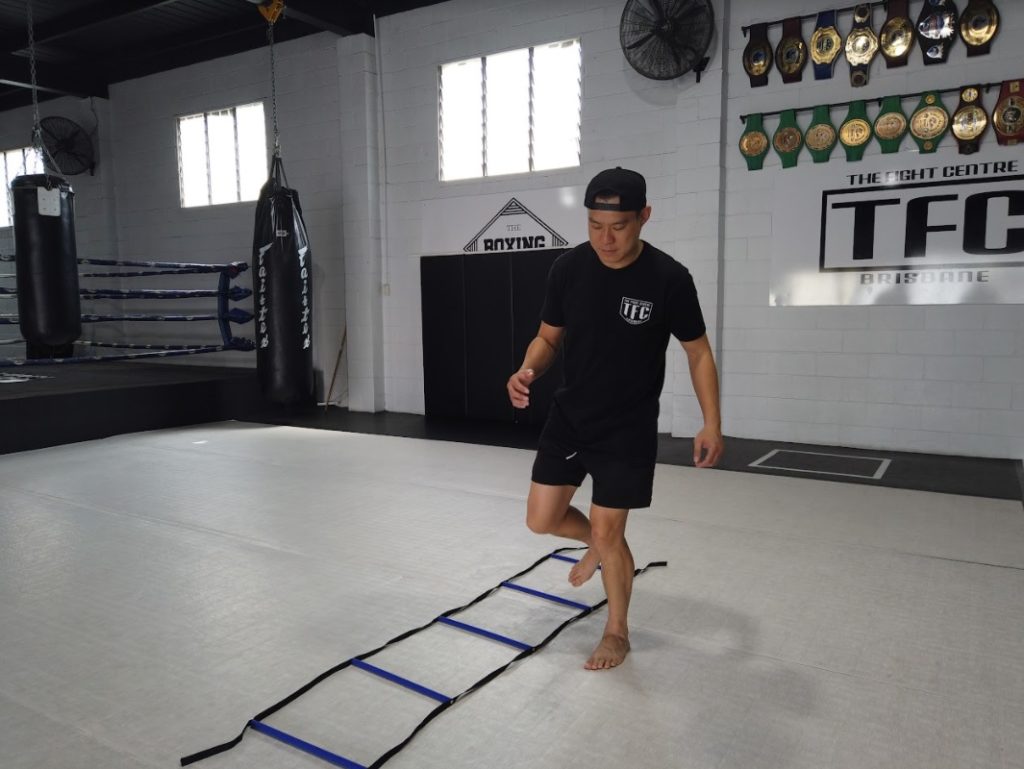Upcoming Events
No event available, please check back again, thank you.
Latest Articles
Muay Thai Footwork Drills You Can Do at Home
8 October 2021
As your Muay Thai experience increases and you begin to establish some training milestones, you’ll become curious about what you can do outside of class. For some, that might mean extra rounds of drills with a partner or practising on a heavy bag. If neither options are available to you, however, what then? Well, here’s your answer: Muay Thai footwork drills.
Doing Muay Thai footwork drills may not be as flashy as dropping bomb kicks on the heavy bag, of course. Make no mistake, though, it’s no less important. Good footwork helps with agility, balance, and coordination—qualities every fighter must have. These qualities will not only get you out of the way of any incoming shots, it’ll put you in a position to deal strikes of your own.
So when the gym is closed for the weekend, and you’re itching to get some practise in, you can do these Muay Thai drills at home. All you need to get started is a little bit of space, rope, and some tape.
-
Ladder Footwork Drill 1 90 degree Hip Rotation
Kicking is a prominent characteristic of Muay Thai, so you must get your hips used to big movements. The 90-degree hip rotation drill mimics the direction of your hips when you throw a kick and when you pull your leg back.
With your agility ladder laid out, follow the following steps:
1. Stand parallel to the agility ladder with your left foot in a box and the right foot out.
2. Swing your right hip in, bringing your right foot inside the next box. At this point, your feet are in adjacent boxes.
3. Pull your right hip and bring your right foot out. At the same time, use your left foot to do a short jump to the next box.
4. At this point, you will be in the position that you started with, except that you have moved a box forward.
5. Continue until you reach the end of the rope.
6. Repeat the whole thing, but start with your right foot inside and your left foot out this time.
You can do this exercise in three variations, depending on the skill you’re trying to polish:
- Quickly swing your hips inwards and outwards to simulate rapid kicks.
- Snap your hips inward to simulate releasing a strong kick, then draw it back with a relaxed pace.
- Swing your hips inwards at a relaxed pace, then swiftly pull it back. This simulates the movement of pulling your leg back after a kick.
-
Ladder Footwork Drill 2 Icky Shuffle
The icky shuffle is a popular Muay Thai footwork drill, used by athletes in many other sports. This drill is good for coordination and practising your explosive lateral movement, which may become useful in a match.
1. Start by standing parallel to the agility ladder and step the foot closest to the ladder into the first box while keeping the other foot out.
2. Bring your outside foot in…
…and your inside foot out.
3. Step forward with your inside foot.
4. Bring your outside foot in and your inside foot out.
5. Repeat until you reach the end of the ladder.
-
Ladder Footwork Drill 3 Ali Shuffle
The Ali Shuffle is one of Muhammad Ali’s iconic contributions to boxing. He shuffled his feet back and forth and side to side, with quickness and dexterity that would confuse his opponents.
Mastering this footwork will significantly boost your evasiveness and mobility inside the ring. It’ll enable you to dance around your opponent with ease. It’s not a traditional Muay Thai tactic, but it is something you can use for a more dynamic game.
- Facing the ladder, start with the left foot in and the right foot out.
- Pump your feet in and out alternatively, moving sideways along the length of the ladder.
- Keep your weight at the balls of your feet to keep the movement light and fast.
- Pump your arms to the tempo of your feet. This will help with your balance as you speed up your movement.
-
Box Step
The Box Step good for practising your footwork to stay balanced while moving forwards, backwards, left or right. It’s actually great for practicing movement in any direction you need. You could also flow with a bit of shadow boxing as you go through the motions to keep it interesting. All you need to set this up is a little bit of space and some tape.
1. Create a square on the floor using tape. The square should be big enough for you to comfortably step without opening your stance so much that you’re off balance. We’ve used a square here that’s approximately 80cm x 80cm
2. Stand in your fight stance in the square. You should always have at least one foot on the lines of the square.
3. Practise moving forward, sideways, and backward, never stepping foot outside the square.
Start in your fight stance
When moving forward, step with your front foot while pushing with your rear foot.
Catch your balance with your front foot close your stance with your rear foot returning to your fight stance.
When moving sideways, step with the foot that is closest to the direction you want to move while pushing with the other foot. In this case, we’re moving right so the right foot steps first while the left foot pushes.
Catch your balance and return to your fight stance as the pushing foot completes the movement.
To move backwards, step with the back foot while pushing with the front foot.
Catch your balance with your back foot as your front foot closes your stance returning yourself to the fight position.
Now practice moving the other way with the foot closest to that direction initiating the movement while the other foot pushes.
Catch your balance and return to your fight position ready to go again!
-
BONUS The Slip Rope
While it’s technically a footwork AND head movement drill, the slip rope (or slip cord) is one of the most basic pieces of equipment in boxing. For a simple piece of rope, it has dynamic applications that apply to both Boxing and Muay Thai. Footwork and head movement are the two things you can polish with slip rope drills.
The tricky technician Lerdsila Chumpairtour is the perfect example of how far an evasive fighter can go. With an expert grasp of the teep and head movement, he has established a strong defense that frustrated many of his opponents. He’s so good that his opponents barely graze him:
True, traditional Muay Thai doesn’t typically emphasize head movement. After all, head movement isn’t going to save you from leg and body kicks. When faced with a volume puncher, though, the fighter with no head movement is at a disadvantage.
Slip rope drills can be compounded for complexity. Beginning from the most basic drill, here’s what you can do with the slip rope:
1. Tie the rope at two posts to make a line at your shoulder level.
2. Position yourself at one end and assume the fight stance.
3. Weave under the the rope as you step, staying in your fight stance.
4. Move your body down using your legs, not by bending yourself at the waist. Drop your torso rather than bending forward (and looking down at the floor).
This drill helps you get used to stepping correctly, staying on your toes, and driving off your back foot rather than dragging it forward. It is also good practice for weaving under punches.
From here, you can incorporate two punching variations as you go down the length of the rope:
- Weaving under punches (the rope) puts you in a crouched position. This is the perfect ground for an uppercut. Weave left, left uppercut. Weave right, right uppercut.
- Throw a jab-cross on either side of the rope. Slip left, jab, cross. Slip right, jab, cross.
-
Final Thoughts
There’s no doubting that footwork is one of the most important skills to learn for Muay Thai. Whether you’re using it offensively, defensively or in most cases a mix of both, great footwork is a signature of a well trained Muay Thai practitioner!


















